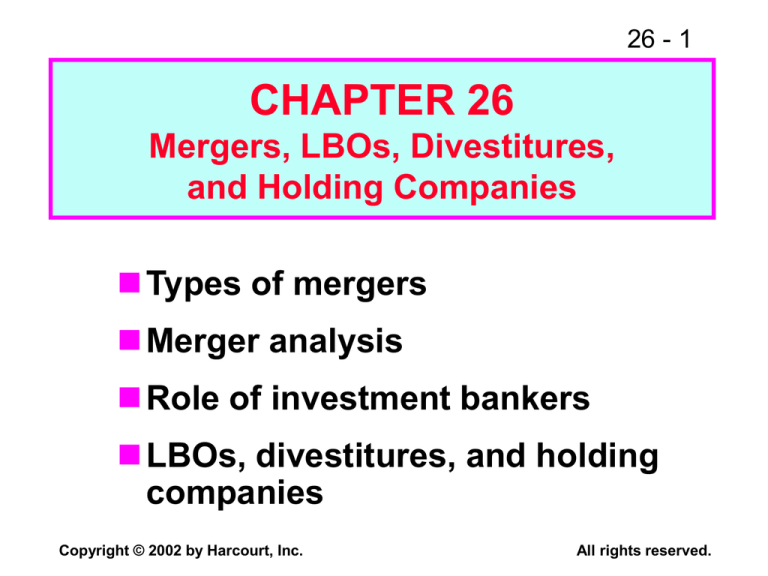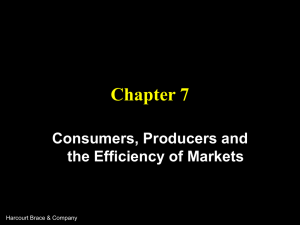
26 - 1
CHAPTER 26
Mergers, LBOs, Divestitures,
and Holding Companies
Types of mergers
Merger analysis
Role of investment bankers
LBOs, divestitures, and holding
companies
Copyright © 2002 by Harcourt, Inc.
All rights reserved.
26 - 2
What are some valid economic
justifications for mergers?
Synergy: Value of the whole exceeds
sum of the parts. Could arise from:
Operating economies
Financial economies
Differential management efficiency
Taxes (use accumulated losses)
(More...)
Copyright © 2002 by Harcourt, Inc.
All rights reserved.
26 - 3
Break-up value: Assets would be
more valuable if broken up and
sold to other companies.
Copyright © 2002 by Harcourt, Inc.
All rights reserved.
26 - 4
What are some questionable
reasons for mergers?
Diversification
Purchase of assets at below
replacement cost
Acquire other firms to increase
size, thus making it more difficult
to be acquired
Copyright © 2002 by Harcourt, Inc.
All rights reserved.
26 - 5
Five Largest Completed Mergers
(as of January 2001)
VALUE
BUYER
TARGET
Vodafone AirTouch Mannesman
(Billion)
$161
Pfizer
Warner-Lambert
116
America Online
Time Warner
106
Exxon
Mobil
81
Glaxo Wellcome
SmithKline Beecham
74
Copyright © 2002 by Harcourt, Inc.
All rights reserved.
26 - 6
Differentiate between hostile and
friendly mergers
Friendly merger:
The merger is supported by the
managements of both firms.
(More...)
Copyright © 2002 by Harcourt, Inc.
All rights reserved.
26 - 7
Hostile merger:
Target firm’s management resists
the merger.
Acquirer must go directly to the
target firm’s stockholders, try to
get 51% to tender their shares.
Often, mergers that start out
hostile end up as friendly, when
offer price is raised.
Copyright © 2002 by Harcourt, Inc.
All rights reserved.
26 - 8
Reasons why alliances can make more
sense than acquisitions
Access to new markets and
technologies
Multiple parties share risks and
expenses
Rivals can often work together
harmoniously
Antitrust laws can shelter
cooperative R&D activities
Copyright © 2002 by Harcourt, Inc.
All rights reserved.
26 - 9
DCF Valuation Analysis (In Millions)
Cash Flow Statements after Merger Occurs
2002
Net sales
2003
2004
2005
$60.0
$90.0
$112.5
$127.5
Cost of goods sold (60%)
36.0
54.0
67.5
76.5
Selling/admin. expenses
4.5
6.0
7.5
9.0
Interest expense
3.0
4.5
4.5
6.0
$16.5
$25.5
$ 33.0
$ 36.0
6.6
10.2
13.2
14.4
$ 9.9
$15.3
$ 19.8
$ 21.6
0.0
7.5
6.0
4.5
$ 9.9
$ 7.8
$ 13.8
$ 17.1
EBT
Taxes (40%)
Net income
Retentions
Cash flow
Copyright © 2002 by Harcourt, Inc.
All rights reserved.
26 - 10
Conceptually, what is the appropriate
discount rate to apply to the
target’s cash flows?
Estimated cash flows are residuals
that belong to the shareholders of the
acquiring firm.
They are riskier than the typical capital
budgeting cash flows, because
including fixed interest charges
increases the volatility.
(More...)
Copyright © 2002 by Harcourt, Inc.
All rights reserved.
26 - 11
Because the cash flows are equity
flows, they should be discounted
using a cost of equity rather than an
overall cost of capital.
Note that the cash flows reflect the
target’s business risk, not the
acquiring company’s.
However, if the merger will affect the
target’s leverage and tax rate, then it
will affect its financial risk.
Copyright © 2002 by Harcourt, Inc.
All rights reserved.
26 - 12
Discount Rate Calculation
ks(Target) = kRF + (kM - kRF)bTarget
= 9% + (4%)1.3 = 14.2%.
Copyright © 2002 by Harcourt, Inc.
All rights reserved.
26 - 13
Horizon, or Continuing, Value
(2005 Cash flow)(1 g)
Horizon value =
ks g
$17.1(1.06)
= 0.142 0.06
= $221.0 million.
Copyright © 2002 by Harcourt, Inc.
All rights reserved.
26 - 14
What Is the Value of the Target Firm to the
Acquiring Shareholders? (In Millions)
Annual cash flow
Terminal value
Net cash flow
Value =
$9.9
(1.142)1
2002
$9.9
2003
$7.8
$9.9
$7.8
+
$7.8
(1.142)2
+
2004 2005
$13.8 $ 17.1
221.0
$13.8 $238.1
$13.8
(1.142)3
+
$238.1
(1.142)4
= $163.9 million.
Copyright © 2002 by Harcourt, Inc.
All rights reserved.
26 - 15
Would another potential acquirer
obtain the same value?
No. The cash flow estimates would
be different, both due to forecasting
inaccuracies and to differential
synergies.
Further, a different beta estimate,
financing mix, or tax rate would
change the discount rate.
Copyright © 2002 by Harcourt, Inc.
All rights reserved.
26 - 16
Assume the target company has
10 million shares outstanding. The
stock last traded at $9 per share,
which reflects the target’s value on a
stand-alone basis. How much should
the acquiring firm offer?
Copyright © 2002 by Harcourt, Inc.
All rights reserved.
26 - 17
Estimate of target’s value = $163.9 million
Target’s current value
= $ 90.0 million
Merger premium
= $ 73.9 million
Presumably, the target’s value is
increased by $73.9 million due to
merger synergies, although realizing
such synergies has been problematic
in many mergers.
(More...)
Copyright © 2002 by Harcourt, Inc.
All rights reserved.
26 - 18
The offer could range from $9 to
$163.9/10 = $16.39 per share.
At $9, all merger benefits would go to
the acquiring firm’s shareholders.
At $16.39, all value added would go to
the target firm’s shareholders.
The graph on the next slide
summarizes the situation.
Copyright © 2002 by Harcourt, Inc.
All rights reserved.
26 - 19
Change in
Shareholders’
Wealth
Acquirer
Target
$9.00
0
5
Copyright © 2002 by Harcourt, Inc.
$16.39
10
15
Bargaining Range =
Synergy
20
Price
Paid for
Target
All rights reserved.
26 - 20
Points About Graph
Nothing magic about crossover price.
Actual price would be determined by
bargaining. Higher if target is in better
bargaining position, lower if acquirer
is.
If target is good fit for many acquirers,
other firms will come in, price will be
bid up. If not, could be close to $9.
(More...)
Copyright © 2002 by Harcourt, Inc.
All rights reserved.
26 - 21
Acquirer might want to make high
“preemptive” bid to ward off other
bidders, or low bid and then plan to
go up. Strategy is important.
Do target’s managers have 51% of
stock and want to remain in control?
What kind of personal deal will
target’s managers get?
Copyright © 2002 by Harcourt, Inc.
All rights reserved.
26 - 22
Assuming a market multiple of 12-14
times EPS, use the market multiple
method to value the stock.
2002 EPS
2003 EPS
= $ 9.90 million
= 15.30
$ 25.20 million
Divided by 2 = Average = $ 12.60 million
12 x Avg. EPS
14 x Avg. EPS
Copyright © 2002 by Harcourt, Inc.
= $151.20 million
= $176.40 million
All rights reserved.
26 - 23
Which valuation method is better,
DCF or market multiple?
Both methods have significant implementation problems.
Confidence in DCF cash flow forecasts
and discount rate is often low.
Validity of market multiple method
depends on comparability of firms and
ability of EPS to capture synergies.
Judgment is key to final valuation.
Copyright © 2002 by Harcourt, Inc.
All rights reserved.
26 - 24
Do mergers really create value?
According to empirical evidence,
acquisitions do create value as a result
of economies of scale, other synergies,
and/or better management.
Shareholders of target firms reap most
of the benefits, that is, the final price is
close to full value.
Target management can always say no.
Competing bidders often push up prices.
Copyright © 2002 by Harcourt, Inc.
All rights reserved.
26 - 25
What are the two methods of
accounting for mergers?
Pooling of interests:
Assumes a merger among equals.
New balance sheet is merely the sum of
the two existing balance sheets.
No income statement effects other than
summing the two income statements.
(More...)
Copyright © 2002 by Harcourt, Inc.
All rights reserved.
26 - 26
Purchase:
The assets of the acquired firm are
“written up” to reflect purchase price if it
is greater than the net asset value.
Goodwill is often created, which appears
as an asset on the balance sheet.
Common equity account is increased to
balance assets and claims.
Goodwill is amortized and expensed over
time, thus reducing future reported
earnings.
Copyright © 2002 by Harcourt, Inc.
All rights reserved.
26 - 27
What are some merger-related
activities of investment bankers?
Identifying targets
Arranging mergers
Developing defensive tactics
Establishing a fair value
Financing mergers
Arbitrage operations
Copyright © 2002 by Harcourt, Inc.
All rights reserved.
26 - 28
What is a leveraged buyout (LB0)?
In an LBO, a small group of
investors, normally including
management, buys all of the
publicly held stock, and hence
takes the firm private.
Purchase often financed with debt.
After operating privately for a
number of years, investors take
the firm public to “cash out.”
Copyright © 2002 by Harcourt, Inc.
All rights reserved.
26 - 29
What are are the advantages and
disadvantages of going private?
Advantages:
Administrative cost savings
Increased managerial incentives
Increased managerial flexibility
Increased shareholder participation
Disadvantages:
Limited access to equity capital
No way to capture return on
investment
Copyright © 2002 by Harcourt, Inc.
All rights reserved.
26 - 30
What are the major types of
divestitures?
Sale of an entire subsidiary to
another firm.
Spinning off a corporate subsidiary
by giving the stock to existing
shareholders.
Carving out a corporate subsidiary
by selling a minority interest.
Outright liquidation of assets.
Copyright © 2002 by Harcourt, Inc.
All rights reserved.
26 - 31
What motivates firms to divest assets?
Subsidiary worth more to buyer than
when operated by current owner.
To settle antitrust issues.
Subsidiary’s value increased if it
operates independently.
To change strategic direction.
To shed money losers.
To get needed cash when distressed.
Copyright © 2002 by Harcourt, Inc.
All rights reserved.
26 - 32
What are holding companies?
A holding company is a corporation
formed for the sole purpose of owning
the stocks of other companies.
In a typical holding company, the
subsidiary companies issue their own
debt, but their equity is held by the
holding company, which, in turn, sells
stock to individual investors.
Copyright © 2002 by Harcourt, Inc.
All rights reserved.
26 - 33
What are the advantages and
disadvantages of holding companies?
Advantages:
Control with fractional ownership.
Isolation of risks.
Disadvantages:
Partial multiple taxation.
Ease of enforced dissolution.
Copyright © 2002 by Harcourt, Inc.
All rights reserved.












